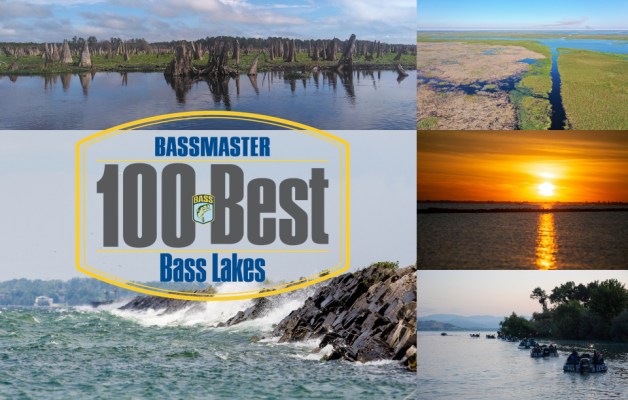![<h4>1. Clear Lake, California </h4>
[43,785 acres] Flooding kept Californiaâs largest natural lake closed to boaters for part of the year, giving bass an opportunity to take advantage of the added habitat with no pressure. When anglers could get out, five-fish limits of 25- to 30-plus pounds were found often. The champions of the 30th Annual Lake County Chamber of Commerce Clear Lake Team Tournament finished the two-day contest with 64.78. Yep, thatâs an average of more than 32 pounds per day! There were 10 bass over 10 pounds caught.](http://www.bassmaster.com/wp-content/uploads/2017/07/bbl_0top12_03_1_clearlake_dsc_3791_bass_-1.jpg)
[43,785 acres] Flooding kept Californiaâs largest natural lake closed to boaters for part of the year, giving bass an opportunity to take advantage of the added habitat with no pressure. When anglers could get out, five-fish limits of 25- to 30-plus pounds were found often. The champions of the 30th Annual Lake County Chamber of Commerce Clear Lake Team Tournament finished the two-day contest with 64.78. Yep, thatâs an average of more than 32 pounds per day! There were 10 bass over 10 pounds caught.
![<h4>2. Sacramento-San Joaquin Delta, California </h4>
[1,153 square miles] Itâs been several years since largemouth in the midteens have been seen in the Deltaâs maze of rivers, sloughs and flooded islands. And with the size needed for tournament big fish honors down by about a pound this year, the trend continues. The system, however, remains one of the nationâs best fisheries with 8âs and 9âs still common. It took 32.29 and 31.57 to win American Bass contests here in March and April, respectively.](http://www.bassmaster.com/wp-content/uploads/2017/07/bbl_0top12_05_2_sacramento_150430srca0511_bass_seven_seas_creations_ink._seigo_saito.jpg)
[1,153 square miles] Itâs been several years since largemouth in the midteens have been seen in the Deltaâs maze of rivers, sloughs and flooded islands. And with the size needed for tournament big fish honors down by about a pound this year, the trend continues. The system, however, remains one of the nationâs best fisheries with 8âs and 9âs still common. It took 32.29 and 31.57 to win American Bass contests here in March and April, respectively.
![<h4>3. Lake Berryessa, California</h4>
[20,700 acres] The end of the Golden Stateâs drought brought with it the second greatest annual increase in the Âhistory of Berryessa water levels. The photo to the right was taken during the drought. Water is overflowing into the giant drain right now. The 45-foot rise inundated fish habitat hasnât seen water in years and is expected to boost already excellent largemouth, smallmouth and spotted bass fisheries. Just shy of 37 pounds won an American Bass tournament held here in April, with a 13.89-pound kicker anchoring the championâs limit.](http://www.bassmaster.com/wp-content/uploads/2017/07/bbl_0top12_06_3_lakeberryessa_dsc_9551.jpg)
[20,700 acres] The end of the Golden Stateâs drought brought with it the second greatest annual increase in the Âhistory of Berryessa water levels. The photo to the right was taken during the drought. Water is overflowing into the giant drain right now. The 45-foot rise inundated fish habitat hasnât seen water in years and is expected to boost already excellent largemouth, smallmouth and spotted bass fisheries. Just shy of 37 pounds won an American Bass tournament held here in April, with a 13.89-pound kicker anchoring the championâs limit.
![<h4>4. New Bullards Bar Reservoir, California</h4> [4,790 acres] Emerald-green waters seem out of place in a reservoir only an hourâs drive from Sacramento, but the huge spotted bass swimming in them make anglers from all over feel at home. Since late 2015, more than one potential world record has been caught here, but none qualified due to technicalities. In February of this year Âanother monster spotted bass was landed. Nick Dulleckâs pending state and world Ârecord stands at 11.25 pounds!](http://www.bassmaster.com/wp-content/uploads/2017/07/bbl_w_4_bullardsbar_20170228_135603.jpg)
![<h4>5. Saguaro Lake, Arizona</h4> [1,264 acres] The bass fishing at this Salt River impoundment can be tough at times, but when theyâre biting, youâll be glad you made the trip. Saguaro is known for quality before quantity, with the size of the largemouth steadily increasing over the past several years. And it doesnât look like that trend is ready to peak. Big bass at an April Midweek Bass Anglers team tournament weighed a whopping 9.35 pounds. It took 23.45 to win that event.](http://www.bassmaster.com/wp-content/uploads/2017/07/bbl_w_5_saguarolake_azgfd_saguaro_lake_morning_fishing.jpg)
![<h4>6. Lake Coeur dâAlene, Idaho</h4> [25,000 acres] The sportfishing program coordinator for the Idaho Department of Fish and Game says this glacially formed lake is the best bass fishery in the state. Double-digit fish days are common, with tournament anglers sometimes needing more than 25 pounds to win. It took 20 pounds to finish in the Top 8 at a Panhandle Bass Anglers open event in April. Species-specific big fish included a 7.52 largemouth and 5.56 smallie.](http://www.bassmaster.com/wp-content/uploads/2017/07/bbl_w_6_coeurdalene_cda_lake_d1a9306.jpg)
![<h4>7. Diamond Valley Lake, California</h4> [4,500 acres] Southern Californiaâs largest reservoir wasnât built on a Âwatercourse and contained no fish when filled. Consequently, managers had an opportunity to create the kind of fishery they wanted. Biologists successfully produced one of the regionâs best trophy fisheries, using near-pure Florida-strain largemouth. Limits averaging almost 5 pounds per fish were needed to win American Bass contests here in February, March and April.](http://www.bassmaster.com/wp-content/uploads/2017/07/bbl_w_7_diamondvalleylake_dvl_fisherman.jpg)
![<h4>8. Lake Havasu, Arizona/California</h4> [19,300 acres] The Arizona Game and Fish Department, along with other stakeholders, has been adding artificial habitat here as part of a fisheries improvement program. And anglers are now benefiting from these efforts. With near-equal numbers of largemouth and smallmouth, you can successfully target the species of your choice. A new Colorado River waters smallmouth record for Arizona was set here in February with an impressive 6.28-pound fish.](http://www.bassmaster.com/wp-content/uploads/2017/07/bbl_w_8_lake_havasu_150507lhaz_0317_bass_seven_seas_creations_ink._seigo_saito.jpg)
![<h4>9. New Melones Lake, California</h4> [12,500 acres] Despite its consistent lack of water, this Sierra foothills reservoir is known for its productive bass fishery. And with this past winterâs extensive precipitation, conditions are even better. Largemouth are the primary target here, with both numbers and quality common. Big fish during a December Anglerâs Choice Western Rookie League event weighed 18.11 pounds, making it one of the largest bass ever caught during a tournament.](http://www.bassmaster.com/wp-content/uploads/2017/07/bbl_w_9_newmelones_20170418_185658.jpg)
![<h4>10. Apache Lake, Arizona</h4> [2,568 acres] Nestled in the Superstition Wilderness, Apache sees fewer anglers than other Arizona waters thanks to its remoteness. Combine the reduced pressure with its typically consistent water levels and the results are a superb largemouth and smallmouth fishery. It took better than a 3-pound average to finish in the Top 8 at a Bass Junkyz tournament in March. Big fish of the contest were 8.81- and 8.23-pound largemouth.](http://www.bassmaster.com/wp-content/uploads/2017/07/bbl_w_10_apache_lake_azgfd_apache_lake-1.jpg)
![<h4>11. Dworshak Reservoir, Idaho</h4> [17,090 acres] Dworshak is known for its kokanee, and the Idaho Department of Fish and Game says there were above-average numbers over the past couple of years. But too many fish equals poor growth. Thatâs good news for bass anglers because the smaller kokanee provide an outstanding source of protein. Hungry smallmouth are the draw here. The Bass Federation held a tournament back in October; big fish was an 8.38 monster smallie.](http://www.bassmaster.com/wp-content/uploads/2017/07/bbl_w_11_dworshakreservoir_dwo-dam4.jpg)
![<h4>12. Columbia River, Oregon/Washington</h4> [191 miles from Portland to McNary Dam] Flowing along most of the border separating Oregon and Washington, this is the largest river in the Pacific Northwest. Despite regulation changes eliminating smallmouth and largemouth creel and size limits, it continues to grow some of the biggest bass in the West. An April Columbia Basin Bass Club event was won with only four fish totaling 23.19. The Âwinnerâs catch included a 7.95-pound largemouth.](http://www.bassmaster.com/wp-content/uploads/2017/07/bbl_w_12_columbiariver_col_r_3.jpg)
![<h4>13. Siltcoos Lake, Oregon</h4> [3,164 acres] Western coastal lakes arenât typically considered great bass fisheries â especially the ones farthest north. Siltcoos, however, was an exception back in its heyday. No one is sure why the bass here took a dive, but the fact is they did. The good news is theyâre making a comeback. The Top 5 teams at an American Bass contest in March weighed more than 17 pounds apiece. The winners had 23.73 that included the 7.95-pound tournament big fish.](http://www.bassmaster.com/wp-content/uploads/2017/07/bbl_w_13_siltcooslake_siltcoos_5.jpg)
![<h4>14. Roosevelt Lake, Arizona</h4> [21,493 acres] Theodore Roosevelt Lake is the largest body of water in central Arizona, and the fish are equally big. Conditions couldnât be Âbetter this year, with more Âwater than during any of the past five years and lots of submerged wood, brush and man-made reef balls providing ideal habitat for bass. The state record smallmouth was caught here in 1988. Big fish at the 27th Âannual Gary Pykare Bass Tournament in April was a largemouth tipping the scales at 7.68.](http://www.bassmaster.com/wp-content/uploads/2017/07/bbl_w_14_rooseveltlake_azgfd_roosevelt_lake_2.jpg)
![<h4>15. Potholes Reservoir, Washington</h4> [27,800 acres] When OâSullivan Dam was constructed and the reservoir filled, the inundation of a number of naturally Âoccurring depressions earned Potholes its name. The result was a bass fishing mecca with over 1,000 seasonally submerged, Âwillow-covered islands. Largemouth dominate, but there are quality smallmouth in rocky areas, too. Twenty-one fish over 6 pounds were caught at the Potholes Bass Clubâs 38th annual open in April.](http://www.bassmaster.com/wp-content/uploads/2017/07/potholes_reservoir_wa_joe_mabel-scaled.jpg)
![<h4>16. Sand Hollow Reservoir, Utah</h4> [1,322 acres] This relatively young reservoir, open to fishing for only 14 years, has managed to produce numbers of quality largemouth. A regulation allowing anglers to keep six bass, with only one fish over 12 inches, is in part responsible for the number of trophies available. An Ultimate Bass Team Tour tournament, held March 25, was won with four fish weighing 18.7 pounds. Big fish at a Southern Utah Bass Anglers event in February was a giant 7-11.](http://www.bassmaster.com/wp-content/uploads/2017/07/bbl_w_16_sandhollow_reservoir_sandhollowbeach2_joenewman.jpg)
![<h4>17. Tenmile Lake, Oregon</h4> [1,626 acres] Oregon Âbiologists tell us that Tenmile was originally a coldwater fishery supporting salmon and steelhead. Over many years, however, watershed Âalterations converted it to a warm-water-species-dominated lake. Today it is one of the best bass fisheries in the Pacific Northwest. It took 20.43 pounds to claim victory at an American Bass team tournament in March. The winners had a 7.40-pound fish that also won the big-bass prize.](http://www.bassmaster.com/wp-content/uploads/2017/07/bbl_w_17_tenmilelake_tenmile_8.jpg)
![<h4>18. Moses Lake, Washington </h4>[6,800 acres] Bruce Bolding, Washington Department of Fish & Wildlifeâs Warmwater Fish Program manager, rates Moses one of the top two bass fisheries in the state. Smallmouth are king here, with fish exceeding 5 pounds common, but there are huge largemouth in select areas, too. An 8.12 largemouth was the heaviest fish caught at a big bass derby held in April.](http://www.bassmaster.com/wp-content/uploads/2017/07/bbl_w_18_moseslake_moses_lake_pic2.jpg)
![<h4>19. C.J. Strike Reservoir, Idaho </h4>[7,500 acres] Created by the damming of the Snake and Bruneau rivers, the relatively long and narrow arms of this high desert lake stay colder than other reservoirs in the region. Smallmouth make up the bulk of the catches here, with tournament Âanglers who find a largemouth or two typically winning. Only one largemouth was brought to the scales during an Idaho Bassmasters pro-am contest in April, with the 5.42-pound bass good for big fish.](http://www.bassmaster.com/wp-content/uploads/2017/07/bbl_w_19_cjstrikereservoir_idgf_jacks_creek_cj_strike_reservoir.jpg)
![<h4>20. Lake Mohave, Nevada/Arizona</h4> [26,500 acres] This narrow Colorado River impoundment transitions from riverine to reservoir conditions in Eldorado Canyon. There, cold, nutrient-rich inflows mix with warmer reservoir waters to jump-start the food chain. The result, Âaccording to the Nevada Department of Wildlife, has been increasing numbers of shad, and more baitfish leads to better fishing. A Southern Utah Bass Anglers contest, held March 11 and 12, was won with 35.44 pounds.](http://www.bassmaster.com/wp-content/uploads/2017/07/bbl_w_20_lakemohave_azgfd_lake_mohave-.jpg)
![<h4>21. Brownlee Reservoir, Idaho/Oregon </h4>[15,000 acres] Viewed from the air, the most upstream impoundment of the three-dam Hells Canyon complex looks more like a wide river than a reservoir. Its shoreline is steep and rocky, Âproviding fantastic habitat for big smallmouth bass. There are also some largemouth in the shallower weedy Âareas. It took 17.95 to win an Idaho Bassmasters event in March. Smallies made up 99 percent of the fish weighed.](http://www.bassmaster.com/wp-content/uploads/2017/07/bbl_w_21_brownlee_reservoir_brownlee_.jpg)
![<h4>22. Lake Powell, Utah/Arizona </h4>[108,335 acres] This picturesque, flooded Colorado River gorge offers over 2,000 miles of shoreline. And when youâre not admiring the views, there are lots of largemouth and smallmouth to be had. Youâll often find 5- or 6-pound fish weighed at tournaments here, but this isnât a trophy fishery. What you can expect are 50-plus-bass days with fish in the 2 1/2- to 3 1/2-pound class. An average of 16.2 pounds were needed to win the contests we reviewed this past spring.](http://www.bassmaster.com/wp-content/uploads/2017/07/bbl_w_22_lake_powell_pb100994_utahdicvsionwildliferesources.jpg)
![<h4>23. Elephant Butte Reservoir, New Mexico </h4>[36,500 acres] This Rio Grande reservoir was known for its bass, but the fishing here suffered during a string of low-water years. Theyâre recovering, however, thanks to Âincreasing lake levels, stocking, voluntary no-fishing areas and the addition of structure. Itâs not back to record-breaking potential yet, but there are lots of 3-plus-pounders to be caught. An American Bass tournament in April was won with only four fish for 13.93 pounds!](http://www.bassmaster.com/wp-content/uploads/2017/07/bbl_w_23_elephantbutte_10256983_10104930854854164_3068460865572681559_o.jpg)
![<h4>24. Lake Mead, Nevada/Arizona</h4> [158,080 acres] This Colorado River reservoir is the largest, in terms of capacity, in the country. Its size, coupled with the number of people it serves, also makes it one of the most drought-impacted bodies of water. But levels are up, according to the Nevada Department of Wildlife, and so are the catch rates. The first- and second-place duos at an Ultimate Bass Team Tour event in March each brought 17-plus pounds to the scales. Big fish at this one was 5.29.](http://www.bassmaster.com/wp-content/uploads/2017/07/bbl_w_24_lake_mead_mg_0449_bass_ronnie_moore.jpg)
![<h4>25. Noxon Rapids Reservoir, Montana</h4> [7,700 acres] Yes, Montana is considered a trout state. But there is plenty of warm water for bass at Noxon Rapids. Expansive shallow flats dotted with submerged stumps provide lots of structure. Most target smallmouth from 2 to 3 pounds, but there are quality largemouth, too â including the current state record. It took almost 40 pounds to finish in the Top 5 at the Montana B.A.S.S. Nation three-day state championship here last August.](http://www.bassmaster.com/wp-content/uploads/2017/07/bbl_w_25_noxonrapids_moose_in_noxon_res.jpg)




